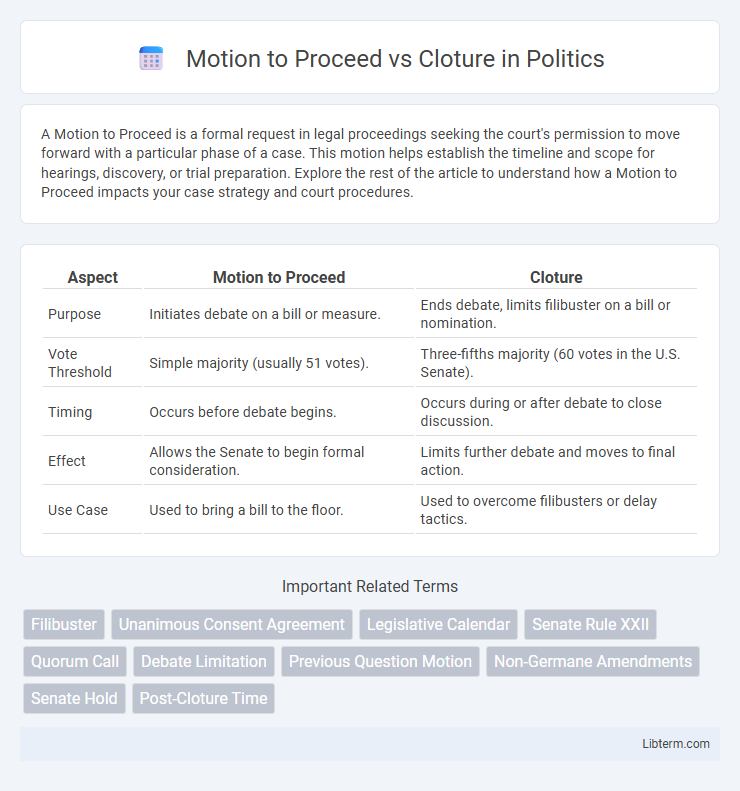A Motion to Proceed is a formal request in legal proceedings seeking the court's permission to move forward with a particular phase of a case. This motion helps establish the timeline and scope for hearings, discovery, or trial preparation. Explore the rest of the article to understand how a Motion to Proceed impacts your case strategy and court procedures.
Table of Comparison
| Aspect | Motion to Proceed | Cloture |
|---|---|---|
| Purpose | Initiates debate on a bill or measure. | Ends debate, limits filibuster on a bill or nomination. |
| Vote Threshold | Simple majority (usually 51 votes). | Three-fifths majority (60 votes in the U.S. Senate). |
| Timing | Occurs before debate begins. | Occurs during or after debate to close discussion. |
| Effect | Allows the Senate to begin formal consideration. | Limits further debate and moves to final action. |
| Use Case | Used to bring a bill to the floor. | Used to overcome filibusters or delay tactics. |
Understanding Senate Legislative Procedures
Motion to Proceed initiates Senate debate on a bill or nomination, setting the stage for discussion by overcoming potential delays. Cloture is a procedural tool used to end debate, requiring a three-fifths majority of 60 senators to prevent filibuster and move the legislative process forward. Mastery of these motions is essential for navigating the Senate's complex rules and advancing legislation efficiently.
What Is a Motion to Proceed?
A Motion to Proceed is a procedural step in the U.S. Senate that allows members to begin debate on a particular bill or measure. It is essential because without approval of the motion, formal consideration of the legislation cannot start. This motion often faces strategic opposition, making it a critical hurdle before moving forward with votes or cloture to limit debate.
Definition of Cloture in the Senate
Cloture in the Senate is a procedural motion aimed at ending debate on a legislative matter to overcome a filibuster, requiring a three-fifths majority vote, typically 60 senators, to pass. This mechanism limits further discussion and forces a timely vote, ensuring that a minority cannot indefinitely delay Senate proceedings. In contrast, a motion to proceed initiates debate on a bill or resolution but does not itself end debate or cut off filibusters.
Key Differences Between Motion to Proceed and Cloture
A Motion to Proceed is a procedural step that allows the Senate to begin formal consideration of a bill or nomination, requiring a simple majority vote to move forward. Cloture is a specific Senate rule designed to end debate on a measure, requiring a three-fifths majority (typically 60 votes) to overcome a filibuster and limit further discussion. While a Motion to Proceed initiates debate, Cloture terminates extended debate and moves the Senate toward final action.
The Role of Debate in Senate Motions
The Role of Debate in Senate Motions distinguishes Motion to Proceed and Cloture by their impact on Senate floor discussions. Motion to Proceed initiates debate on a bill or measure, allowing senators to discuss its merits and propose amendments, often leading to prolonged deliberation. Cloture serves to limit debate time and end filibusters, requiring a supermajority vote to cut off further discussion and move directly to a final vote, balancing extended debate rights with legislative efficiency.
Historical Context: Filibuster and Cloture
The historical context of the Motion to Proceed and Cloture is deeply tied to the evolution of the Senate filibuster, which emerged in the early 19th century as a tactic to extend debate and delay legislation. Cloture, first invoked in 1917 following a filibuster against arming merchant ships, was established to limit debate and end filibusters by requiring a supermajority vote. Over time, the Motion to Proceed became a strategic parliamentary tool to bring a bill or measure to the floor for debate, often preceding attempts to invoke Cloture to overcome filibusters and expedite the legislative process.
Voting Requirements for Motion to Proceed vs Cloture
The Motion to Proceed in the U.S. Senate requires a simple majority vote of 51 senators to open debate on a bill or motion. Cloture, aimed at ending debate and overcoming a filibuster, demands a three-fifths majority, typically 60 out of 100 senators, to invoke. These distinct voting thresholds reflect the varying levels of Senate consent necessary to advance legislation versus to limit debate and force a vote.
Real-World Examples of Senate Motions
Motion to Proceed allows the Senate to begin debate on a bill or nomination, exemplified by the 2021 Motion to Proceed on the American Jobs Plan, which set the stage for legislative consideration. Cloture, invoked to end debate and overcome filibusters, was notably used in 2020 to pass the National Defense Authorization Act by limiting debate to 30 hours. These motions are strategic tools that shape the legislative timeline and influence Senate decision-making dynamics.
Political Implications of Procedural Votes
Motion to Proceed and Cloture votes significantly shape legislative dynamics by determining the Senate's ability to debate and advance bills or nominations. A successful Motion to Proceed signals majority control and sets the legislative agenda, while invoking Cloture limits debate time, curbing filibusters and facilitating final votes, often reflecting partisan tensions. These procedural tools impact political strategy by influencing negotiation power, minority rights, and the broader balance of power within Congress.
Impact on Legislative Outcomes
The Motion to Proceed sets the stage for debate, determining whether a bill advances to detailed discussion, directly influencing the legislative agenda's momentum. Cloture serves as a critical mechanism to end filibusters, limiting debate to 30 hours and enabling a Senate vote, thus preventing legislative gridlock. Together, these procedural tools shape legislative outcomes by controlling debate flow and timing, impacting the likelihood of bill passage.
Motion to Proceed Infographic

 libterm.com
libterm.com